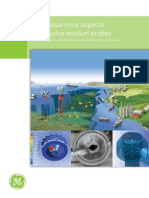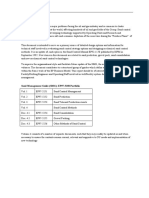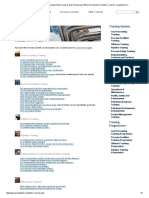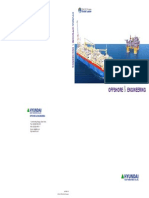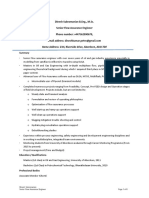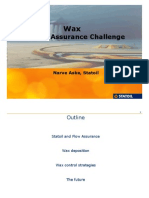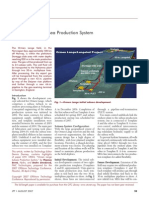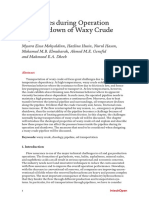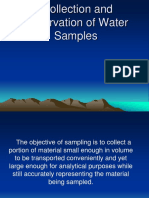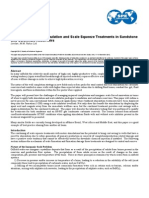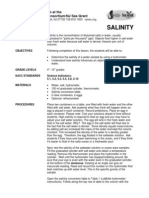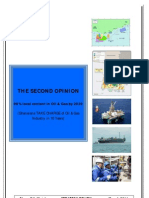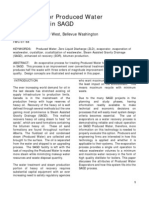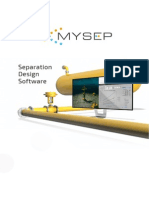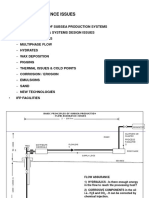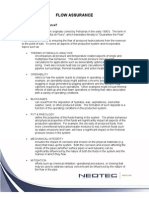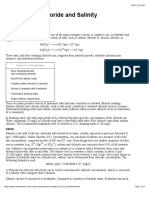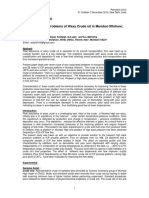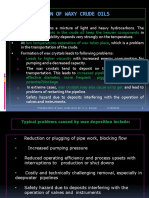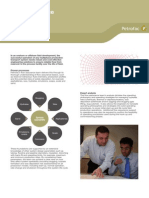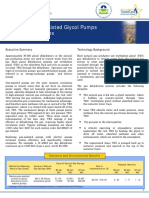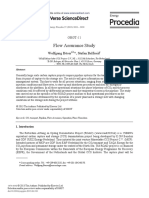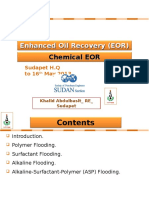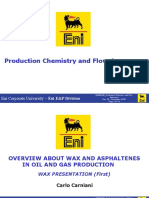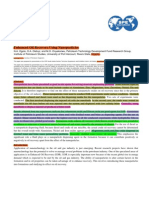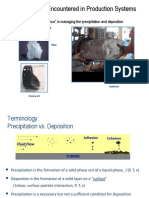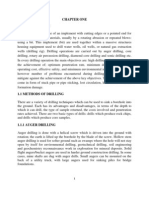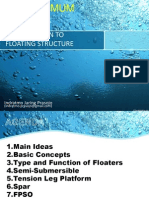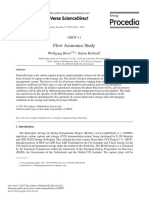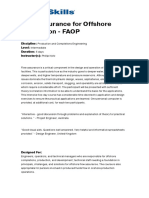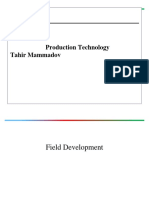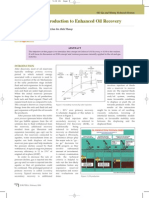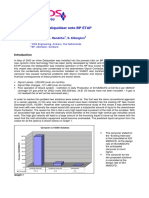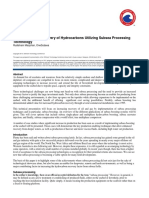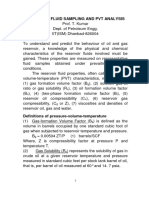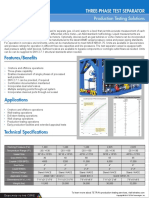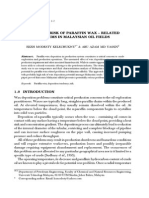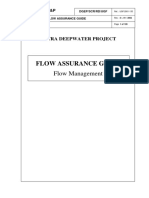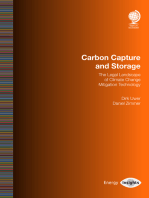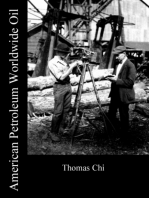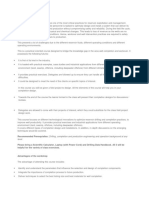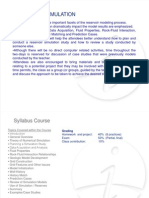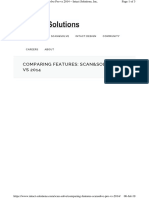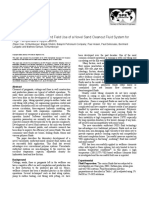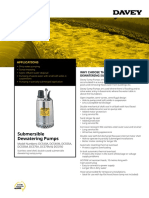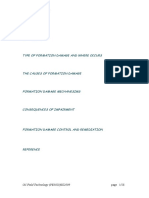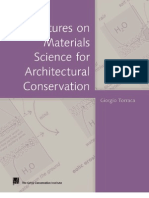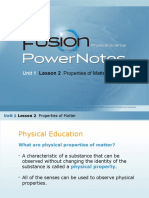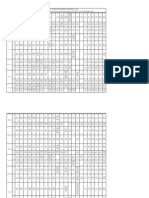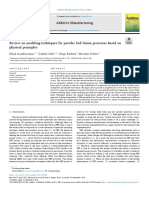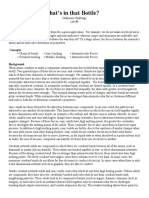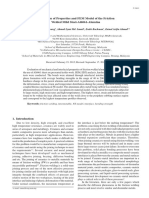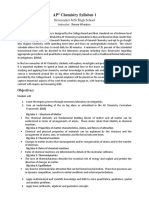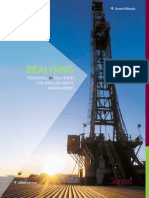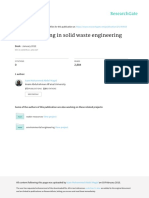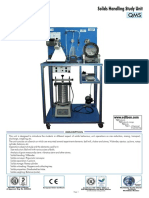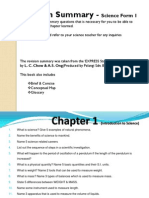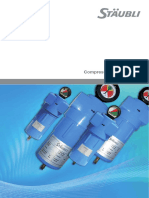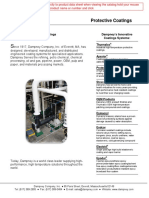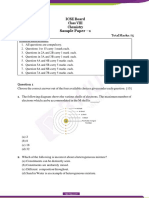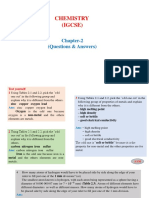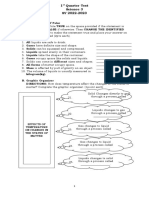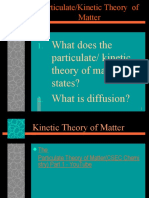Professional Documents
Culture Documents
0 ratings0% found this document useful (0 votes)
127 viewsModule 2.1 - Basic Flow Assurance PDF
Module 2.1 - Basic Flow Assurance PDF
Uploaded by
Ayuku KidaFlow assurance aims to keep the flow path open by developing strategies to optimize production and control solids accumulation. It involves generating thermal models, evaluating production enhancement methods, and recommending solutions to problems like slugging and viscous flow. Key roles include defining design and operational requirements to manage solids like hydrates, wax, asphaltenes, ice and scale. Flow assurance also addresses corrosion, erosion, and fluid chemistry issues, and interfaces with reservoir, pipeline and well engineering. The overall objective is to introduce flow assurance and common problems it addresses.
Copyright:
© All Rights Reserved
Available Formats
Download as PDF, TXT or read online from Scribd
You might also like
- GEOG TI2012 Flow Assurance Aspects of Intrusive Erosion ProbesDocument10 pagesGEOG TI2012 Flow Assurance Aspects of Intrusive Erosion ProbesIsmail SayutiNo ratings yet
- EP 97-5250 Sand Management Guide (SMG) - Preface PDFDocument2 pagesEP 97-5250 Sand Management Guide (SMG) - Preface PDFKhalid ZaeemNo ratings yet
- 13-Oil and Gas Facilities Training Public Courses Gas Processing Offshore Production Facilities - John M. Campbell & CoDocument3 pages13-Oil and Gas Facilities Training Public Courses Gas Processing Offshore Production Facilities - John M. Campbell & Coxjaf01No ratings yet
- Offshore HyuNDAIDocument26 pagesOffshore HyuNDAIbetahita_80174No ratings yet
- Dinesh Subramanian CV 190606Document8 pagesDinesh Subramanian CV 190606Dinesh KumarNo ratings yet
- A Flow Assurance Challenge: Narve Aske, StatoilDocument28 pagesA Flow Assurance Challenge: Narve Aske, StatoilVinh PhamthanhNo ratings yet
- Flow AssuranceDocument7 pagesFlow AssuranceMubarik AliNo ratings yet
- Ormen Lange Subsea Production SystemDocument3 pagesOrmen Lange Subsea Production Systemssmanian68100% (2)
- Treatment of EmulsionDocument7 pagesTreatment of EmulsionSaurab DevanandanNo ratings yet
- EDC H2S and Gas TestingDocument24 pagesEDC H2S and Gas TestingAboZaidNo ratings yet
- Challenges During Operation and Shutdown of Waxy Crude PipelinesDocument13 pagesChallenges During Operation and Shutdown of Waxy Crude PipelinesJesseNo ratings yet
- Collection and Preservation of Water SamplesDocument24 pagesCollection and Preservation of Water SamplesSyed Talha AhmedNo ratings yet
- SPE 160703 Simultaneous Well Stimulation and Scale Squeeze Treatments in Sandstone and Carbonate ReservoirsDocument21 pagesSPE 160703 Simultaneous Well Stimulation and Scale Squeeze Treatments in Sandstone and Carbonate ReservoirsJose Miguel GonzalezNo ratings yet
- SalinityDocument3 pagesSalinitynageswaraRaoNo ratings yet
- Gow Strategy Review March 2011Document15 pagesGow Strategy Review March 2011Shraddha GhagNo ratings yet
- Guidelines For Produced Water Evaporators in SAGD 2007Document16 pagesGuidelines For Produced Water Evaporators in SAGD 2007pipedown456No ratings yet
- Fpso Revamp For A Marginal Field Ea-SpeDocument34 pagesFpso Revamp For A Marginal Field Ea-Spe고병석No ratings yet
- MySep Software Brochure PDFDocument7 pagesMySep Software Brochure PDFoverlord5555No ratings yet
- Petroleum: Mahdi Zeinali Hasanvand, Mohammad Ali Ahmadi, Reza Mosayebi BehbahaniDocument7 pagesPetroleum: Mahdi Zeinali Hasanvand, Mohammad Ali Ahmadi, Reza Mosayebi Behbahanimarcoesteban97No ratings yet
- L02 - Flow AssuranceDocument31 pagesL02 - Flow Assuranceariful islamNo ratings yet
- Flow Assurance Nov6Document5 pagesFlow Assurance Nov6Vinh PhamthanhNo ratings yet
- Chloride and SalinityDocument8 pagesChloride and SalinitysalahudinNo ratings yet
- Flow Assurance Problems of Waxy Crude Oil in Mumbai Offshore - Case StudiesDocument6 pagesFlow Assurance Problems of Waxy Crude Oil in Mumbai Offshore - Case Studiesأصلان أصلان100% (1)
- Transportation of Waxy Crude OilsDocument23 pagesTransportation of Waxy Crude OilsIshan Haider100% (2)
- FlowAssurance - PetrofacDocument2 pagesFlowAssurance - Petrofacvpandya1981No ratings yet
- Replacing Gas-Assisted Glycol Pumps With Electric Pumps: Lessons LearnedDocument11 pagesReplacing Gas-Assisted Glycol Pumps With Electric Pumps: Lessons LearnedAmji ShahNo ratings yet
- Flow Assurance Study: Wolfgang Böser, Stefan BelfroidDocument13 pagesFlow Assurance Study: Wolfgang Böser, Stefan BelfroidAhmed RamadanNo ratings yet
- Early Production FacilityDocument2 pagesEarly Production FacilitySenthilkumar Pragasam100% (1)
- ChemicalDocument37 pagesChemicalMohanad Hussien100% (1)
- Modeling and Simulation of The Temperature Profile Along Offshore Pipeline of An Oil and Gas Flow: Effect of Insulation MaterialsDocument8 pagesModeling and Simulation of The Temperature Profile Along Offshore Pipeline of An Oil and Gas Flow: Effect of Insulation MaterialsInternational Journal of Innovative Science and Research Technology100% (1)
- SAGD Where Valves Are UsedDocument4 pagesSAGD Where Valves Are UsedAnonymous ntK705RtNo ratings yet
- Production SystemsDocument24 pagesProduction SystemsAsad KhanNo ratings yet
- 3 Production Chemistry and Flow Assurance Monday CarnianiDocument13 pages3 Production Chemistry and Flow Assurance Monday CarnianiWael BadriNo ratings yet
- Enhanced Oil Recovery Using NanoparticlesDocument9 pagesEnhanced Oil Recovery Using NanoparticlesAbdul Sattar Al-MalikiNo ratings yet
- Flow AssuranceDocument22 pagesFlow AssuranceAlberto100% (1)
- Seminar WorkDocument50 pagesSeminar Workodii victor ogbonnayaNo ratings yet
- Introduction To Floating StructureDocument68 pagesIntroduction To Floating StructurenthongNo ratings yet
- Boser Belfroid Flow Assurance StudyDocument13 pagesBoser Belfroid Flow Assurance StudyAnonymous ibRJX1EvgNo ratings yet
- Petroskills Training On Flow AssuranceDocument4 pagesPetroskills Training On Flow AssuranceRajarshiPanigrahiNo ratings yet
- Lecture 1 - 1 - Course Notes PDFDocument67 pagesLecture 1 - 1 - Course Notes PDFFaraj NabiyevNo ratings yet
- Reusing Produced Water (SPE White Paper) PDFDocument6 pagesReusing Produced Water (SPE White Paper) PDFMubin Ashraf Sheikh100% (1)
- An Introduction To EORDocument4 pagesAn Introduction To EORMnesNo ratings yet
- Installation of A Deliquidiser Onto BP ETAP PDFDocument6 pagesInstallation of A Deliquidiser Onto BP ETAP PDFhermit44535No ratings yet
- How To Increase Recovery of Hydrocarbons Utilizing Subsea Processing TechnologyDocument14 pagesHow To Increase Recovery of Hydrocarbons Utilizing Subsea Processing TechnologySara AguilarNo ratings yet
- Mercury Contamination RisksDocument78 pagesMercury Contamination RisksguruhnurizalNo ratings yet
- 4d - Reservoir Fluid Sampling and PVT Analysis and Rs CorrelationsDocument23 pages4d - Reservoir Fluid Sampling and PVT Analysis and Rs CorrelationsTHE TERMINATORNo ratings yet
- Features/Benefits: Production Testing Solutions Three-Phase Test SeparatorDocument1 pageFeatures/Benefits: Production Testing Solutions Three-Phase Test SeparatorJayesh SanganiNo ratings yet
- Potential Risk of Paraffin Wax - RelatedDocument7 pagesPotential Risk of Paraffin Wax - RelatedJohn HastingNo ratings yet
- Acidizing Flowback Optimization For Tight Sandstone Gas ReservoirsDocument6 pagesAcidizing Flowback Optimization For Tight Sandstone Gas ReservoirsBolsec14No ratings yet
- FlowAssuranceGuide Total PDFDocument128 pagesFlowAssuranceGuide Total PDFAlisha BasukiNo ratings yet
- Otc 18681Document10 pagesOtc 18681Cadu PradoNo ratings yet
- BP Culzean Crude Quality-BrochureDocument2 pagesBP Culzean Crude Quality-BrochureRon CNo ratings yet
- Carbon Capture and Storage: The Legal Landscape of Climate Change Mitigation TechnologyFrom EverandCarbon Capture and Storage: The Legal Landscape of Climate Change Mitigation TechnologyNo ratings yet
- Essential Practices for Managing Chemical Reactivity HazardsFrom EverandEssential Practices for Managing Chemical Reactivity HazardsNo ratings yet
- Well Design Drilling and WorkoverDocument6 pagesWell Design Drilling and Workovers33d_2010100% (1)
- CLASS Reservoir SimulationDocument50 pagesCLASS Reservoir SimulationJosé Timaná100% (1)
- 11b WWW - Intact Solutions - Com Scan Solve Comparing FeaturesDocument2 pages11b WWW - Intact Solutions - Com Scan Solve Comparing Featuresmilic_31No ratings yet
- Laboratory Investigation and Field Use of A Novel Sand Cleanout Fluid System ForDocument5 pagesLaboratory Investigation and Field Use of A Novel Sand Cleanout Fluid System Formohamadi42No ratings yet
- Sump PumpsDocument2 pagesSump PumpsMohammad ZeeshanNo ratings yet
- Formation Damage 3Document28 pagesFormation Damage 3Suleiman BaruniNo ratings yet
- Torraca, G. Materials Sciencie Architectural Conservation. 2009Document206 pagesTorraca, G. Materials Sciencie Architectural Conservation. 2009Trinidad Pasíes Arqueología-ConservaciónNo ratings yet
- Unit 1: Lesson 2 Properties of MatterDocument11 pagesUnit 1: Lesson 2 Properties of MatterAbeer Alnajjar عبير النجارNo ratings yet
- Final UG TT PDFDocument3 pagesFinal UG TT PDFsridharegspNo ratings yet
- Additive Manufacturing: Balaji Soundararajan, Daniele Sofia, Diego Barletta, Massimo PolettoDocument27 pagesAdditive Manufacturing: Balaji Soundararajan, Daniele Sofia, Diego Barletta, Massimo PolettoHarris DanielNo ratings yet
- 8 Thhourlab 9 BakerbrunatikallalkaneoberlanderDocument5 pages8 Thhourlab 9 Bakerbrunatikallalkaneoberlanderapi-297169088No ratings yet
- Evaluation of Properties and FEM Model of The Friction Welded Mild Steel-Al6061-AluminaDocument15 pagesEvaluation of Properties and FEM Model of The Friction Welded Mild Steel-Al6061-AluminaKamel FedaouiNo ratings yet
- Matter and Its PropertiesDocument10 pagesMatter and Its PropertiesGerald CatiponNo ratings yet
- Chem 1 Worksheet 1Document22 pagesChem 1 Worksheet 1For PhcornerNo ratings yet
- Ap Chem Audit 1Document15 pagesAp Chem Audit 1api-475547739No ratings yet
- Ihsan Ullah Khan ThesisDocument66 pagesIhsan Ullah Khan ThesisBehramand KhanNo ratings yet
- Scomi Oiltools DWMS OverviewDocument16 pagesScomi Oiltools DWMS Overviewmojtaba_m007No ratings yet
- Problem Solving in Solid Waste EngngDocument66 pagesProblem Solving in Solid Waste Engnghalder_kalyan9216No ratings yet
- 05 Solids Handling Study UnitDocument3 pages05 Solids Handling Study UnitAbdulmajid OsmanNo ratings yet
- Revision Summary - Science Form 1Document8 pagesRevision Summary - Science Form 1Beevy GB100% (1)
- New Prospects in Flame Retardant Polymer MaterialsDocument116 pagesNew Prospects in Flame Retardant Polymer Materialsspkacrl100% (2)
- United States Patent Office: Patented Apr. 6, 1971Document3 pagesUnited States Patent Office: Patented Apr. 6, 1971Alexander Franco CastrillonNo ratings yet
- FSB PDFDocument8 pagesFSB PDFAlper SakalsizNo ratings yet
- Module 4 - Conduction and Breakdown in Solid DielectricsDocument49 pagesModule 4 - Conduction and Breakdown in Solid DielectricsFah Rukh0% (1)
- CatalogDocument102 pagesCatalogeissa16No ratings yet
- 085 - ME8491, ME6403 Engineering Metallurgy - Notes 4Document144 pages085 - ME8491, ME6403 Engineering Metallurgy - Notes 4Dark ranger YtNo ratings yet
- ICSE Class 8 Chemistry Sample Paper 1Document7 pagesICSE Class 8 Chemistry Sample Paper 1Laxmi Pathak100% (1)
- 2 Ig (Q&a)Document17 pages2 Ig (Q&a)EaintNo ratings yet
- Unit Ii - Gas-Solid Non-Catalytic ReactorsDocument18 pagesUnit Ii - Gas-Solid Non-Catalytic ReactorsThirunavuk KarasuNo ratings yet
- Phys Sci GR 10 Summaries, Terms, Definitions, Activities 9 April 2020Document206 pagesPhys Sci GR 10 Summaries, Terms, Definitions, Activities 9 April 2020Tasmiyah Kader100% (3)
- 1st Quarter Test Science 3 2022-2023 RagyDocument2 pages1st Quarter Test Science 3 2022-2023 RagyAnn GeluaNo ratings yet
- Chemistry Grade 10 States of MatterDocument40 pagesChemistry Grade 10 States of MatterTrudy- Ann CaineNo ratings yet
Module 2.1 - Basic Flow Assurance PDF
Module 2.1 - Basic Flow Assurance PDF
Uploaded by
Ayuku Kida0 ratings0% found this document useful (0 votes)
127 views13 pagesFlow assurance aims to keep the flow path open by developing strategies to optimize production and control solids accumulation. It involves generating thermal models, evaluating production enhancement methods, and recommending solutions to problems like slugging and viscous flow. Key roles include defining design and operational requirements to manage solids like hydrates, wax, asphaltenes, ice and scale. Flow assurance also addresses corrosion, erosion, and fluid chemistry issues, and interfaces with reservoir, pipeline and well engineering. The overall objective is to introduce flow assurance and common problems it addresses.
Original Description:
Original Title
Module 2.1 - Basic Flow Assurance.pdf
Copyright
© © All Rights Reserved
Available Formats
PDF, TXT or read online from Scribd
Share this document
Did you find this document useful?
Is this content inappropriate?
Report this DocumentFlow assurance aims to keep the flow path open by developing strategies to optimize production and control solids accumulation. It involves generating thermal models, evaluating production enhancement methods, and recommending solutions to problems like slugging and viscous flow. Key roles include defining design and operational requirements to manage solids like hydrates, wax, asphaltenes, ice and scale. Flow assurance also addresses corrosion, erosion, and fluid chemistry issues, and interfaces with reservoir, pipeline and well engineering. The overall objective is to introduce flow assurance and common problems it addresses.
Copyright:
© All Rights Reserved
Available Formats
Download as PDF, TXT or read online from Scribd
Download as pdf or txt
0 ratings0% found this document useful (0 votes)
127 views13 pagesModule 2.1 - Basic Flow Assurance PDF
Module 2.1 - Basic Flow Assurance PDF
Uploaded by
Ayuku KidaFlow assurance aims to keep the flow path open by developing strategies to optimize production and control solids accumulation. It involves generating thermal models, evaluating production enhancement methods, and recommending solutions to problems like slugging and viscous flow. Key roles include defining design and operational requirements to manage solids like hydrates, wax, asphaltenes, ice and scale. Flow assurance also addresses corrosion, erosion, and fluid chemistry issues, and interfaces with reservoir, pipeline and well engineering. The overall objective is to introduce flow assurance and common problems it addresses.
Copyright:
© All Rights Reserved
Available Formats
Download as PDF, TXT or read online from Scribd
Download as pdf or txt
You are on page 1of 13
SSIC Module 2.
Basic Flow Assurance Principles
Subsea Systems Integration Course
Module Objective
• Objective: To introduce flow assurance as a discipline and briefly
describe flow assurance problems found in many projects.
• At the end of this session you will be able to:
o Describe common flow assurance problems
Subsea Systems Integration Course
What is Flow Assurance?
• Basic Definition of Flow Assurance – Keeping the Flow Path Open
• Key Roles
•Develop strategies to optimize production
•Develop strategies to control accumulation of solids that can block the
flow path & to remove solids if they become a problem
•Translate flow assurance strategies into required functionality for system
design, Operability strategies, and requirements for chemical injection
•Provide solutions for other problems related to flow and/or produced
fluid chemistry (e.g., corrosion, erosion, emulsions, foaming)
•Scope – The flow assurance scope is typically from the perforations to
the host
Subsea Systems Integration Course
FA Role: Optimize Production
• Generate thermal-hydraulic models of the system(s) and
determine the best choices for optimizing production
• Line sizing
• Number of lines required
• Evaluate and recommend methods for production
enhancement
• Gas Lift – riser base
• Subsea boosting
• Recommend solutions for flow “problems” such as slugging,
viscous flow, and others
Subsea Systems Integration Course
Slugging Control
Dril-Quip S3 Installation – Penguin Tie-in, Gannet Platform
Photo courtesy Ian Wood
Subsea Systems Integration Course
FA Role: Develop Strategies to Manage Solids
Why Do Solids Form? Due to change in conditions from reservoir to host
Types of Solids to Manage:
• Hydrates – Gas stabilized solid form of water similar to “ice”.
Drivers: T, P, wc, oc
• Wax – Solid paraffin deposits from oil. Drivers: T, OC, p
• Asphaltenes – Solids components of black oils. Drivers: OC, P, t
• Ice – Ice can form in subsea systems with T < 0oC. Drivers: T, wc
• Scale – Inorganic solids formed from produced water. Drivers: T, WC, p
T,t-temperature, P,p-pressure, OC, oc-Oil composition, WC, wc – water composition
Subsea Systems Integration Course
Hydrates
Photo Courtesy SGI-OGUA Hydrate Team
Subsea Systems Integration Course
Wax
Photos courtesy SGSI-OGUA Wax Team
Subsea Systems Integration Course
Asphaltenes and Scale
Photo courtesy M. Mataya, SEPCo & Photo Courtesty Grant
Gibson Subsea Systems Integration Course
FA Role. Define Design & Operating Requirements
• FA Strategies Are Composed of Up to Three Elements
• Design Functionality – ex., insulation, flowlines size, umbilical
number & size
• Operability – procedures carried out by Operations staff. Note: for
flow assurance, procedures often must be carried within a given time
• Chemicals – chemicals often used to control FA problems. Ex.,
methanol, glycol, inhibitors
• Strategies are Developed Throughout Project Execution and During
Operating Phase
• Strategies Balance Costs (CAPEX, OPEX), Ease of Operation,
Risk vs. Remediation
Subsea Systems Integration Course
FA Role: Manage Other Problems
• FA Engineer’s Scope Often Includes
• Corrosion management
• Erosion management
• Foaming, emulsions – due to fluid chemistry or fluid additives
• Well Engineering: Wellbore thermal-hydraulic modeling
• Enhanced production – waterfloods, gas lift, boosting
• FA Engineer May Also Fill a Systems Engineering Role
• Systems-based decision making
• Interface management
Subsea Systems Integration Course
Flow Assurance: Interfaces
• Flow Assurance Interfaces With:
• Project Systems Engineer
• Pipeline Engineer – line sizing, insulation (external, PIP)
• Umbilical Engineer – number & types of chemical delivery lines
• Tree/Manifold – injection points, erosion calculations
• Well Engineer – completion design, hydrate concerns for annulus
• Reservoir Engineer – Expected production functions, modeling
• Production Chemist – chemical selection, produced fluid chemistry
Subsea Systems Integration Course
Module Objective
• Objective: To introduce flow assurance as a discipline and briefly
describe flow assurance problems found in many projects.
• At the end of this session you will be able to:
o Describe common flow assurance problems
Subsea Systems Integration Course
You might also like
- GEOG TI2012 Flow Assurance Aspects of Intrusive Erosion ProbesDocument10 pagesGEOG TI2012 Flow Assurance Aspects of Intrusive Erosion ProbesIsmail SayutiNo ratings yet
- EP 97-5250 Sand Management Guide (SMG) - Preface PDFDocument2 pagesEP 97-5250 Sand Management Guide (SMG) - Preface PDFKhalid ZaeemNo ratings yet
- 13-Oil and Gas Facilities Training Public Courses Gas Processing Offshore Production Facilities - John M. Campbell & CoDocument3 pages13-Oil and Gas Facilities Training Public Courses Gas Processing Offshore Production Facilities - John M. Campbell & Coxjaf01No ratings yet
- Offshore HyuNDAIDocument26 pagesOffshore HyuNDAIbetahita_80174No ratings yet
- Dinesh Subramanian CV 190606Document8 pagesDinesh Subramanian CV 190606Dinesh KumarNo ratings yet
- A Flow Assurance Challenge: Narve Aske, StatoilDocument28 pagesA Flow Assurance Challenge: Narve Aske, StatoilVinh PhamthanhNo ratings yet
- Flow AssuranceDocument7 pagesFlow AssuranceMubarik AliNo ratings yet
- Ormen Lange Subsea Production SystemDocument3 pagesOrmen Lange Subsea Production Systemssmanian68100% (2)
- Treatment of EmulsionDocument7 pagesTreatment of EmulsionSaurab DevanandanNo ratings yet
- EDC H2S and Gas TestingDocument24 pagesEDC H2S and Gas TestingAboZaidNo ratings yet
- Challenges During Operation and Shutdown of Waxy Crude PipelinesDocument13 pagesChallenges During Operation and Shutdown of Waxy Crude PipelinesJesseNo ratings yet
- Collection and Preservation of Water SamplesDocument24 pagesCollection and Preservation of Water SamplesSyed Talha AhmedNo ratings yet
- SPE 160703 Simultaneous Well Stimulation and Scale Squeeze Treatments in Sandstone and Carbonate ReservoirsDocument21 pagesSPE 160703 Simultaneous Well Stimulation and Scale Squeeze Treatments in Sandstone and Carbonate ReservoirsJose Miguel GonzalezNo ratings yet
- SalinityDocument3 pagesSalinitynageswaraRaoNo ratings yet
- Gow Strategy Review March 2011Document15 pagesGow Strategy Review March 2011Shraddha GhagNo ratings yet
- Guidelines For Produced Water Evaporators in SAGD 2007Document16 pagesGuidelines For Produced Water Evaporators in SAGD 2007pipedown456No ratings yet
- Fpso Revamp For A Marginal Field Ea-SpeDocument34 pagesFpso Revamp For A Marginal Field Ea-Spe고병석No ratings yet
- MySep Software Brochure PDFDocument7 pagesMySep Software Brochure PDFoverlord5555No ratings yet
- Petroleum: Mahdi Zeinali Hasanvand, Mohammad Ali Ahmadi, Reza Mosayebi BehbahaniDocument7 pagesPetroleum: Mahdi Zeinali Hasanvand, Mohammad Ali Ahmadi, Reza Mosayebi Behbahanimarcoesteban97No ratings yet
- L02 - Flow AssuranceDocument31 pagesL02 - Flow Assuranceariful islamNo ratings yet
- Flow Assurance Nov6Document5 pagesFlow Assurance Nov6Vinh PhamthanhNo ratings yet
- Chloride and SalinityDocument8 pagesChloride and SalinitysalahudinNo ratings yet
- Flow Assurance Problems of Waxy Crude Oil in Mumbai Offshore - Case StudiesDocument6 pagesFlow Assurance Problems of Waxy Crude Oil in Mumbai Offshore - Case Studiesأصلان أصلان100% (1)
- Transportation of Waxy Crude OilsDocument23 pagesTransportation of Waxy Crude OilsIshan Haider100% (2)
- FlowAssurance - PetrofacDocument2 pagesFlowAssurance - Petrofacvpandya1981No ratings yet
- Replacing Gas-Assisted Glycol Pumps With Electric Pumps: Lessons LearnedDocument11 pagesReplacing Gas-Assisted Glycol Pumps With Electric Pumps: Lessons LearnedAmji ShahNo ratings yet
- Flow Assurance Study: Wolfgang Böser, Stefan BelfroidDocument13 pagesFlow Assurance Study: Wolfgang Böser, Stefan BelfroidAhmed RamadanNo ratings yet
- Early Production FacilityDocument2 pagesEarly Production FacilitySenthilkumar Pragasam100% (1)
- ChemicalDocument37 pagesChemicalMohanad Hussien100% (1)
- Modeling and Simulation of The Temperature Profile Along Offshore Pipeline of An Oil and Gas Flow: Effect of Insulation MaterialsDocument8 pagesModeling and Simulation of The Temperature Profile Along Offshore Pipeline of An Oil and Gas Flow: Effect of Insulation MaterialsInternational Journal of Innovative Science and Research Technology100% (1)
- SAGD Where Valves Are UsedDocument4 pagesSAGD Where Valves Are UsedAnonymous ntK705RtNo ratings yet
- Production SystemsDocument24 pagesProduction SystemsAsad KhanNo ratings yet
- 3 Production Chemistry and Flow Assurance Monday CarnianiDocument13 pages3 Production Chemistry and Flow Assurance Monday CarnianiWael BadriNo ratings yet
- Enhanced Oil Recovery Using NanoparticlesDocument9 pagesEnhanced Oil Recovery Using NanoparticlesAbdul Sattar Al-MalikiNo ratings yet
- Flow AssuranceDocument22 pagesFlow AssuranceAlberto100% (1)
- Seminar WorkDocument50 pagesSeminar Workodii victor ogbonnayaNo ratings yet
- Introduction To Floating StructureDocument68 pagesIntroduction To Floating StructurenthongNo ratings yet
- Boser Belfroid Flow Assurance StudyDocument13 pagesBoser Belfroid Flow Assurance StudyAnonymous ibRJX1EvgNo ratings yet
- Petroskills Training On Flow AssuranceDocument4 pagesPetroskills Training On Flow AssuranceRajarshiPanigrahiNo ratings yet
- Lecture 1 - 1 - Course Notes PDFDocument67 pagesLecture 1 - 1 - Course Notes PDFFaraj NabiyevNo ratings yet
- Reusing Produced Water (SPE White Paper) PDFDocument6 pagesReusing Produced Water (SPE White Paper) PDFMubin Ashraf Sheikh100% (1)
- An Introduction To EORDocument4 pagesAn Introduction To EORMnesNo ratings yet
- Installation of A Deliquidiser Onto BP ETAP PDFDocument6 pagesInstallation of A Deliquidiser Onto BP ETAP PDFhermit44535No ratings yet
- How To Increase Recovery of Hydrocarbons Utilizing Subsea Processing TechnologyDocument14 pagesHow To Increase Recovery of Hydrocarbons Utilizing Subsea Processing TechnologySara AguilarNo ratings yet
- Mercury Contamination RisksDocument78 pagesMercury Contamination RisksguruhnurizalNo ratings yet
- 4d - Reservoir Fluid Sampling and PVT Analysis and Rs CorrelationsDocument23 pages4d - Reservoir Fluid Sampling and PVT Analysis and Rs CorrelationsTHE TERMINATORNo ratings yet
- Features/Benefits: Production Testing Solutions Three-Phase Test SeparatorDocument1 pageFeatures/Benefits: Production Testing Solutions Three-Phase Test SeparatorJayesh SanganiNo ratings yet
- Potential Risk of Paraffin Wax - RelatedDocument7 pagesPotential Risk of Paraffin Wax - RelatedJohn HastingNo ratings yet
- Acidizing Flowback Optimization For Tight Sandstone Gas ReservoirsDocument6 pagesAcidizing Flowback Optimization For Tight Sandstone Gas ReservoirsBolsec14No ratings yet
- FlowAssuranceGuide Total PDFDocument128 pagesFlowAssuranceGuide Total PDFAlisha BasukiNo ratings yet
- Otc 18681Document10 pagesOtc 18681Cadu PradoNo ratings yet
- BP Culzean Crude Quality-BrochureDocument2 pagesBP Culzean Crude Quality-BrochureRon CNo ratings yet
- Carbon Capture and Storage: The Legal Landscape of Climate Change Mitigation TechnologyFrom EverandCarbon Capture and Storage: The Legal Landscape of Climate Change Mitigation TechnologyNo ratings yet
- Essential Practices for Managing Chemical Reactivity HazardsFrom EverandEssential Practices for Managing Chemical Reactivity HazardsNo ratings yet
- Well Design Drilling and WorkoverDocument6 pagesWell Design Drilling and Workovers33d_2010100% (1)
- CLASS Reservoir SimulationDocument50 pagesCLASS Reservoir SimulationJosé Timaná100% (1)
- 11b WWW - Intact Solutions - Com Scan Solve Comparing FeaturesDocument2 pages11b WWW - Intact Solutions - Com Scan Solve Comparing Featuresmilic_31No ratings yet
- Laboratory Investigation and Field Use of A Novel Sand Cleanout Fluid System ForDocument5 pagesLaboratory Investigation and Field Use of A Novel Sand Cleanout Fluid System Formohamadi42No ratings yet
- Sump PumpsDocument2 pagesSump PumpsMohammad ZeeshanNo ratings yet
- Formation Damage 3Document28 pagesFormation Damage 3Suleiman BaruniNo ratings yet
- Torraca, G. Materials Sciencie Architectural Conservation. 2009Document206 pagesTorraca, G. Materials Sciencie Architectural Conservation. 2009Trinidad Pasíes Arqueología-ConservaciónNo ratings yet
- Unit 1: Lesson 2 Properties of MatterDocument11 pagesUnit 1: Lesson 2 Properties of MatterAbeer Alnajjar عبير النجارNo ratings yet
- Final UG TT PDFDocument3 pagesFinal UG TT PDFsridharegspNo ratings yet
- Additive Manufacturing: Balaji Soundararajan, Daniele Sofia, Diego Barletta, Massimo PolettoDocument27 pagesAdditive Manufacturing: Balaji Soundararajan, Daniele Sofia, Diego Barletta, Massimo PolettoHarris DanielNo ratings yet
- 8 Thhourlab 9 BakerbrunatikallalkaneoberlanderDocument5 pages8 Thhourlab 9 Bakerbrunatikallalkaneoberlanderapi-297169088No ratings yet
- Evaluation of Properties and FEM Model of The Friction Welded Mild Steel-Al6061-AluminaDocument15 pagesEvaluation of Properties and FEM Model of The Friction Welded Mild Steel-Al6061-AluminaKamel FedaouiNo ratings yet
- Matter and Its PropertiesDocument10 pagesMatter and Its PropertiesGerald CatiponNo ratings yet
- Chem 1 Worksheet 1Document22 pagesChem 1 Worksheet 1For PhcornerNo ratings yet
- Ap Chem Audit 1Document15 pagesAp Chem Audit 1api-475547739No ratings yet
- Ihsan Ullah Khan ThesisDocument66 pagesIhsan Ullah Khan ThesisBehramand KhanNo ratings yet
- Scomi Oiltools DWMS OverviewDocument16 pagesScomi Oiltools DWMS Overviewmojtaba_m007No ratings yet
- Problem Solving in Solid Waste EngngDocument66 pagesProblem Solving in Solid Waste Engnghalder_kalyan9216No ratings yet
- 05 Solids Handling Study UnitDocument3 pages05 Solids Handling Study UnitAbdulmajid OsmanNo ratings yet
- Revision Summary - Science Form 1Document8 pagesRevision Summary - Science Form 1Beevy GB100% (1)
- New Prospects in Flame Retardant Polymer MaterialsDocument116 pagesNew Prospects in Flame Retardant Polymer Materialsspkacrl100% (2)
- United States Patent Office: Patented Apr. 6, 1971Document3 pagesUnited States Patent Office: Patented Apr. 6, 1971Alexander Franco CastrillonNo ratings yet
- FSB PDFDocument8 pagesFSB PDFAlper SakalsizNo ratings yet
- Module 4 - Conduction and Breakdown in Solid DielectricsDocument49 pagesModule 4 - Conduction and Breakdown in Solid DielectricsFah Rukh0% (1)
- CatalogDocument102 pagesCatalogeissa16No ratings yet
- 085 - ME8491, ME6403 Engineering Metallurgy - Notes 4Document144 pages085 - ME8491, ME6403 Engineering Metallurgy - Notes 4Dark ranger YtNo ratings yet
- ICSE Class 8 Chemistry Sample Paper 1Document7 pagesICSE Class 8 Chemistry Sample Paper 1Laxmi Pathak100% (1)
- 2 Ig (Q&a)Document17 pages2 Ig (Q&a)EaintNo ratings yet
- Unit Ii - Gas-Solid Non-Catalytic ReactorsDocument18 pagesUnit Ii - Gas-Solid Non-Catalytic ReactorsThirunavuk KarasuNo ratings yet
- Phys Sci GR 10 Summaries, Terms, Definitions, Activities 9 April 2020Document206 pagesPhys Sci GR 10 Summaries, Terms, Definitions, Activities 9 April 2020Tasmiyah Kader100% (3)
- 1st Quarter Test Science 3 2022-2023 RagyDocument2 pages1st Quarter Test Science 3 2022-2023 RagyAnn GeluaNo ratings yet
- Chemistry Grade 10 States of MatterDocument40 pagesChemistry Grade 10 States of MatterTrudy- Ann CaineNo ratings yet
